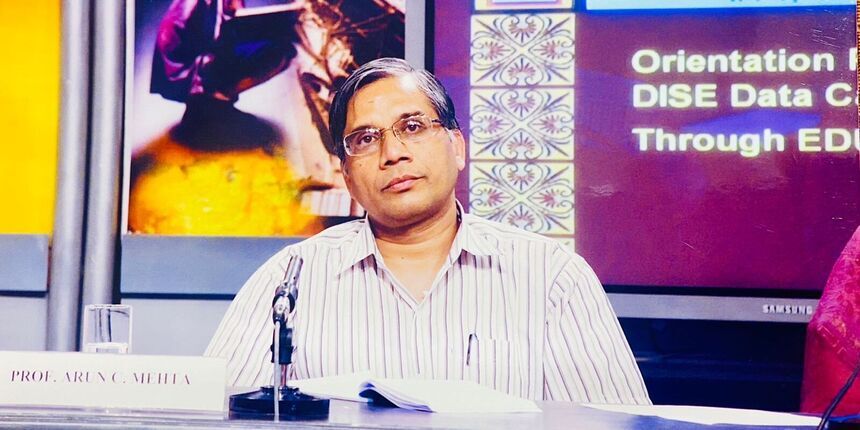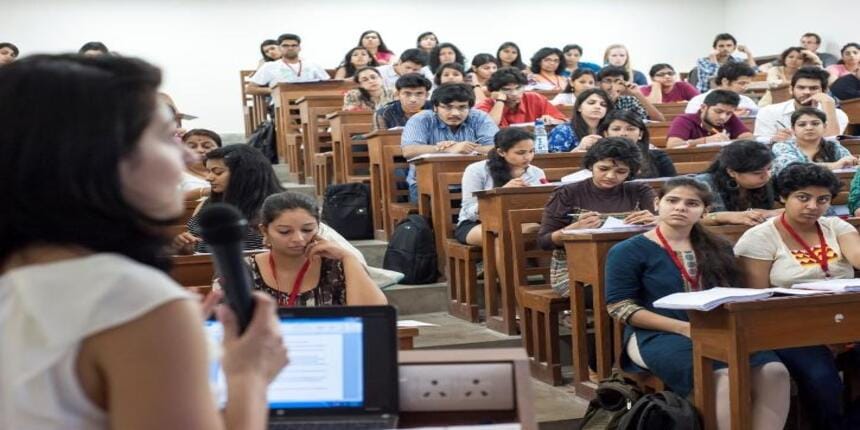‘About 38 lakh children dropped out from Classes 1-8 between 2020-21 and 2021-22’
Prof Arun C Mehta points out that the rise in GER could at least in part be attributed to the decline in total population of children. Also, 6.34 million children left private schools.

Team Careers360 | November 5, 2022 | 11:22 AM IST
By Arun C Mehta
The data collected by the Unified District Information System for Education till September 30, 2021 was released by the education ministry’s department of school education and literacy on November 3, 2022. The report briefly presents analysis of school education at the all-India level and state-specific statements for all states and union territories. The database, now called UDISE+, is being managed by the ministry from 2018-19, and the present report is the third in the series. From 1994-95 to 2017-18, UDISE was managed and nurtured by the National Institute of Educational Planning and Administration (NIEPA) in New Delhi. It is hoped that the ministry will resume the publication series that came with each year’s dataset, from 2005-06 to 2017-18.
Once, the delay in the collation and publication of educational statistics was of a year at the national level, and it seems to have increased. However, the 2021-22 data has taken less time than UDISE+ 2020-21. Since the reporting for UDISE+ is supposedly completely online, it should have come earlier still. Also, the UDISE+ data is yet to be real-time as the latest report contains data that was valid in September 2021.
Here are some quick observations on the UDISE Plus report for 2021-22.
UDISE: Age-specific child population
Like UDISE+ 2019-20 and 2020-21, UDISE+ 2021-22 enrolment indicators are based on child population provided by the July 2020 Report of the Technical Group on Population Projections, National Commission on Population, ministry of health and family welfare which are considered official projections.
The projected child population reveals that the 6-to-13 years population declined to 188.39 million in 2021-22 from 189.59 million in 2020-21, thus showing a decline of 1.20 million. The secondary-age population – 14-to-15 years – declined by 4,75,200; and that of the higher-secondary-age group – 16-to-17 years – by 4,09,400.The improvement in the gross enrolment ratio, if any, in 2021-22 may also be partly because of the decline in the corresponding child population.
Age-specific projected child population
Year | 6-10 years | 11-13 years | |
2019-20 | 11,84,46,400 | 7,23,46,800 | |
2020-21 | 11,81,44,200 | 7,14,48,400 | |
2021-22 | 11,78,42,000 | 7,05,50,000 | |
Change over previous year | -3,02,200 | -8,98,400 | |
14-15 Years | 16-17 Years | ||
2020-21 | 4,89,00,200 | 5,00,56,400 | |
2021-22 | 4,84,25,000 | 4,96,47,000 | |
Change over previous year | -4,75,200 | -4,09,400 | |
Source: UDISE+ 2019-20, 2020-21, 2021-22, ministry of education
Also Read | AP, Rajasthan, Gujarat improve governance to be among top-performing states in education
UDISE Plus statistical tables
On the statistics tables, here are a few key observations.
- Unlike the Flash Statistics published till 2017-18, none of the UDISE+ 2021-22 tables have time-series information. In its absence, one has to separately download and refer to individual year's data. The 2021-22 UDISE+ data presents a comparison with the previous year for a few key indicators but this is only at the all-India level.
- At the national level, while UDISE+ 2019-20 rightly compared indicators with 2012-13 UDISE data, the first year of the merging of the databases for elementary (DISE) and secondary (SEMIS) levels, in UDISE+ 2020-21 and 2021-22 Flash Statistics, indicators have only been compared with 2018-19 and 2019-20, or the year from which the ministry has been managing UDISE. However, state and all-India data from 2012-13 onwards is available on the UDISE portal.
- The UDISE+ 2021-22 report presents scant analysis, and that too only at the all-India level. There’s no state-specific analysis or comment on what the data says about India's efforts towards universal school enrolment. The report failed to flag issues that need immediate attention from planners.
- A few new indicators such as the provision of sufficient books in the school library, academic enrichment activities, introduction of peer learning, training on the psycho-social aspect, orientation on cyber safety to students, identification of hard-spot in learning, teaching tools created by teachers for teaching and learning, creating outcome-based assessment items by teachers for learning, have been introduced in UDISE+ 2021-22 for the first time. This is a welcome step which was incorporated in Samagra Shiksha Abhiyan response to the new National Education Policy (NEP 2020) recommendations.
- Once again, most tables present absolute numbers, which are of limited use and should have been avoided.
- It was expected that the UDISE+ 2021-22 Report would present the entry or intake rate as enrolment in Class 1,along with the corresponding age-six child population is available in ready-to-use form. No meaningful planning can be undertaken without analysing the entry rate.
- In response to changes in the school structure (NEP 2020), the UDISE+ 2021-22 Report failed to present new indicators such as the enrolment ratio at the foundation stage, the transition rate from the foundation to the preparatory stage, etc., or modify the existing indicators even though raw data is available.
Also Read | UNESCO report calls for stronger regulation of private actors in education
UDISE+ 2022-23: Coverage of Schools
The total number of schools declined by 20,021 schools (1.33%) from 2017-18 to 2021-22, the number dropped by 69,788 (4.48%).
UDISE+ 2021-22 is silent on the number of schools covered and starts its analysis directly on enrolment. However, in the section on the impact of the pandemic, it casually throws in this line: “The decline in total schools is mainly due to closure of schools under private and other management." However, the report doesn’t mention that the number of government schools has declined by 9,663 which is 0.94% of the total government schools in the previous year.
The number of schools covered under UDISE+ 2019-20 had declined by 43,292 schools (-2.8%) but no explanation is presented in UDISE+ Report on the reasons for this. Is the decline due to the merger of schools?
While still with NIEPA, UDISE 2017-18 covered 15,58,903 schools. This has dropped to 14,89,115 schools. This indicates that about five of every 100 schools covered in 2017-18 are not covered in 2021-22. The ministry should furnish reasons for this steep decline in schools, the criteria used and whether norms of distance set through the Right to Education Act (RTE Act) were followed.
Number of Schools: All-India
Year | Total schools | Increase/ decrease | % change | Total government schools | Increase/ decrease | Total private schools | Increase/ decrease |
2017-18 | 15,58,903 | 10,94,543 | 3,22,201 | ||||
2018-19 | 15,51,000 | -7,903 | -0.5 | 10,83,747 | -10796 | 3,26,228 | 4,027 |
2019-20 | 15,07,708 | -43,292 | -2.8 | 10,32,570 | -51177 | 3,37,499 | 11,271 |
2020-21 | 15,09,136 | 1,428 | 0.09 | 10,32,149 | -521 | 3,43,314* | 5815 |
2021-22 | 14,89,115 | -20,021 | -1.33 | 10,22,386 | -9663 | 3,35,844 | -7470 |
2017-18 to 2021-22 | -69,788 | -4.48% | -72,157 | -6.59 % | 13,643 | 4.23% |
Source: UDISE & UDISE+, different years. *Number of published schools were 3,40,753 schools in 2020-21
Also Read | Over 33% of SC, ST, OBC students drop out in Class 10: UDISE Plus 2019-20
UDISE Plus: Enrolment
School enrolment in India has never been free from limitations which is also true for UDISE+ data, especially from 2018-19. However, this year there has been a justification for the enrolment shift from private to government management which is largely attributed to Covid-19.
Enrolment trends by school management (2017-18 to 2021-22)
Management | 2017-18 | % of total | 2019-20 | % of total | 2020-21 | % of total | 2021-22 | Change over previous year | % of total |
Government | 13,17,71,929 | 52.5 | 12,81,42,596 | 51.06 | 13,24,25,644 | 52.18 | 14,04,98,718 | 80,73,074 | 54.94 |
Private aided | 2,79,88,493 | 11.15 | 2,70,14,238 | 10.76 | 2,64,46,332 | 10.42 | 2,66,47,860 | 2,01,528 | 10.42 |
Private unaided | 8,33,11,659 | 33.19 | 8,89,13,012 | 35.43 | 8,80,89,385 | 34.71 | 8,24,50,325 | -56,39,060 | 32.24 |
Others | 79,17,112 | 3.15 | 69,01,837 | 2.75 | 68,43,100 | 2.7 | 61,43,720 | -6,99,380 | 2.40 |
Total | 25,09,89,193 | 100 | 25,09,71,683 | 100 | 25,38,04,461 | 100 | 25,57,40,623 | 19,36,162 | 100 |
Source: UDISE+
The total enrolment from Class 1 to 12 in UDISE+ 2021-22 shows an increase of 1.94 million – slightly higher than total enrolment – 25.43 million – in 2012-13, the first year of unification. The UDISE+ 2021-22 data was recorded on September 30, 2021, because of which the impact of COVID may still not be fully reflected. The 2022-23 data may show a bigger shift to government schools.
Both in the absolute (5.64 million) and percentage (6.40 percent) terms, the year 2021-22 has seen a steep decline in enrolment under private unaided management, which is higher than their share in decline in the total number of unaided schools covered under UDISE+ 2021-22.
Despite the decline in the number of government schools, enrolment has increased by a whopping 8.1 million. In addition, enrolment under aided management has also increased by 0.20 million. Other managements have shown a decline of 0.70 million in enrolment.
Together, unaided and other management schools show a decline of 6.34 million in enrolment against a total increase of 8.27 million under government and aided managements. Even if we assume that all those who left private schools joined public ones, there is still an unexplained gap of around 1.63 million.
Also Read | Delhi Government closed down over 200 schools since 2020, teachers allege
Because of the decline in enrolment under private management, the share of enrolment under government management increased to 54.94% in 2021-22 from 52.18% in the previous year. Paralelly, enrolment under private management declined to 32.24% in 2021-22 from 35.43% in 2019-20.
Even though the total enrolment in Classes 1 to 12 in 2021-22 shows an overall increase of 1.94 million, data disaggregated by levels shows that enrolment declined marginally at the primary level.
Further, the decline in secondary enrolment is to the tune of 478 thousand (-1.22%), for which a decline in transition rate from elementary to secondary level of education could be a reason.
On the other hand, upper primary (Classes 6-8) enrolment rose by 9,36,000, with an overall increase of 7,57,000 (0.40 %) at the elementary level of education.
Also Read | UP Schools: Basic technology labs are bringing dropouts, child labourers back to class
Level-specific enrolment: 2020-21 & 2021-22
Level | 2020-21 | 2021-22 | Change | % Change |
Primary | 122021291 | 121842250 | -179041 | -0.15 |
Upper primary | 65854199 | 66790692 | 936493 | 1.42 |
Elementary | 187875490 | 188632942 | 757452 | 0.40 |
Secondary | 39006375 | 38528631 | -477744 | -1.22 |
Higher secondary | 26922596 | 28579050 | 1656454 | 6.15 |
Classes 1-12 | 253804461 | 255740623 | 1936162 | 0.76 |
Source: UDISE+, different years
Enrolment at elementary level: 2021-22
Management | 2017-18 | % | 2019-20 | % | 2020-21 | % | 2021-22 | Change over previous year | % |
Government | 10,58,28,898 | 56.34 | 1,01,682,222 | 54.5 | 1,04,492,647 | 55.62 | 11,10,57,666 | 65,65,019 | 6.28 |
Aided Management | 1,39,78,909 | 7.44 | 1,33,66,824 | 7.16 | 1,28,28,918 | 6.83 | 1,28,56,944 | 28,026 | 0.22 |
Private Unaided | 6,08,60,037 | 32.4 | 6,49,99,102 | 34.84 | 6,40,98,229 | 34.12 | 5,89,49,623 | -51,48,606 | -8.03 |
Others | 71,58,778 | 3.81 | 65,11,942 | 3.49 | 64,55,696 | 3.44 | 57,68,709 | -6,86,987 | -10.64 |
Classes 1-8 | 18,78,26,622 | 100 | 18,65,60,090 | 100 | 18,78,75,490 | 100 | 18,86,32942 | 7,57,452 | 0.40 |
Source: UDISE+, different years.
Also Read | How a Kerala village saved its 98 year-old government school and transformed it
U DISE Plus: School enrolment ratio 2021-22
UDISE+ 2021-22 presents a variety of enrolment ratios, all of which suggest that barring the primary level, the goal of universal school enrolment is still a distant dream. At other levels of school education, universalization is challenging to achieve by 2030 as envisaged in NEP 2020. For example, UDISE+ 2021-22 indicates that about 57.6% of children of 16-to-17 years are not enrolled in the corresponding level of education; about 27.2% of 14-15 year-olds are not enrolled in the secondary level. Further, about 3.5% of children of aged six-13 years are unenrolled, which needs immediate attention.
Adjusted net enrolment ratio at the primary level is reported to be 99.1%, indicating that only 0.9% children aged six-11 years are not enrolled.
Enrolment Ratio: All-India, 2020-21 & 2021-22
Level | GER | NER | Adjusted NER | ASER* | ||||
2020-21 | 2021-22 | 2020-21 | 2021-22 | 2020-21 | 2021-22 | 2020-21 | 2021-22 | |
Primary | 103.3 | 103.4 | 92.7 | 88.6 | 98.6 | 99.1 | 98.6 | 99.1 (6-10 years) |
Upper primary | 92.2 | 94.7 | 74.1 | 71.3 | 84.4 | 87.3 | 91.6 | 92.2 (11-13 years) |
Elementary | 99.1 | 100.1 | 92.1 | 90.5 | 96.0 | 96.5 | 96.0 | 96.5 (6-13 years) |
Secondary | 79.8 | 79.6 | 52.5 | 47.9 | 61.8 | 64.7 | 73.4 | 72.8 (14-15 years) |
Higher secondary | 53.8 | 57.6 | 34.7 | 34.2 | - | - | 46.3 | 42.4 (16-17 years) |
Source: UDISE+ 2020-21& 2021-22 *ASER: Age-specific enrolment ratio.
It is hoped that the UDISE+ portal will present enrolment indices at the disaggregated levels, such as block and district levels, and due attention will be given while formulating the school education Annual Work Plan and Budget under the ongoing SamagraShikshaAbhiyan.The improvement visible in the enrolment ratio (adjusted-NER), especially at secondary and higher secondary levels, is marginal. In fact, irrespective of the level of education, the NER declined in 2021-22 over 2020-21,which is despite a decline in the child population. The ministry’s highlighting an improved GER in the press release for the 2021-22 data presents only the half story.
It may also be important to observe that because of changes in the school structure, a set of new indicators will be required for each of the phases of education.
Also Read | India spends only 0.1% of GDP on early childhood education: Report
Dropout rate rises in primary, upper-primary
Indicators through which the efficiency of an education system is judged have been presented both at the all-India and state levels. Attaining 100% NER is a necessary condition, but to achieve universal enrolment, children must be retained. There has been a steep decline in the average annual dropout rate in recent years but in 2021-22, it has again increased at both primary and upper primary levels.
At the primary level, the dropout rate declined from 4.5% in 2017-18 to 1.5% in 2018-19 and further to 0.8% in 2019-20 but it rose again to 1.5% in 2021-22, which needs further analysis. The UDISE+ dropout rate is computed based on all schools instead of common schools, which had been the practice during 2005-06 to 2017-18, which produced an underestimate of the dropout rates and misleading and absurd results. In 2021-22, as many as 15 states at the primary and eight states at the upper-primary level reported zero dropout rate, which, in fact, is negative but reported zero.
The UIDSE+ authorities may like to switch over to the previous methodology and, in the future, must compute and present flow rates based on common schools. In addition, they must re-compute the numbers for the years 2018-19 to 2021-22 so that they can be used in planning and budgeting. Or, the UDISE+ authorities, must highlight the benefit of considering all schools instead of common schools. It is a wonder how targets on dropout, transition, and retention rates are currently being set and how the implementing authorities monitor the progress and take corrective measures.
Also Read | Uttar Pradesh: Astronomy labs transform 105 Bulandshahr schools, foster ‘community learning’
The dropout rate at the upper primary level increased to 3% in 2021-22 from 1.9% in the previous year. As many as 17,69,309 students in primary and 19,88,797 students in upper primary classes dropped out between the years 2020-21 and 2021-22. About 19% of students who entered Class 1 in 2014-15 couldn't reach Class 8 in 2021-22 and dropped out of the system before completing elementary education.
The dropout at the secondary level is reported to be 12.6%. Further, the transition rate reveals that about 22% of students dropped out from the system between secondary to higher secondary level of education and the retention rate at this level of education is only 65% indicating a high dropout of 35%. The retention rate at the elementary level is reported to be 81.2%, thus indicating about 19% of children dropped out instead of transitioning from one level of education to another. If India has to attain the status of universal school education, there is no option but to improve the efficiency of the education system.
UDISE: Efficiency indicators (2019-20 to 2021-22)
| Indicator | 2019-20 | 2020-21 | 2021-22 |
| Dropout Rate | |||
| Primary | 1.5 | 0.8 | 1.5 |
| Upper primary | 2.6 | 1.9 | 3.0 |
| Secondary | 16.1 | 14.6 | 12.6 |
| Transition Rate | |||
| Primary to Upper Primary | 92.8 | 92.1 | 93.2 |
| Elementaryto Secondary | 91.4 | 91.3 | 88.8 |
| Secondary to Higher Secondary | 71.6 | 73.3 | 78.4 |
| Retention Rate | |||
| Primary (1 to 5) | 87.0 | 95.3 | 95.4 |
| Elementary (1 to 8) | 74.6 | 80.9 | 81.2 |
| Secondary (1 to 10) | 59.6 | 61.5 | 64.7 |
| Higher Secondary (1 to12) | 40.2 | 42.8 | 43.6 |
Source: UDISE+, different years
Further, enrolment data in the recent years has been erratic making it difficult to ascertain the trends in enrolment. The UDISE+ authorities must explain sudden ups and downs in enrolment. Apart from online verification of data by the local authorities, let there be verification of the data by a third-party agency on a sample basis, and it must be initiated by the ministry on a pan-India basis.
Arun C Mehta is former professor and head of the EMIS department at NIEPA, New Delhi.
Follow us for the latest education news on colleges and universities, admission, courses, exams, research, education policies, study abroad and more..
To get in touch, write to us at news@careers360.com.




